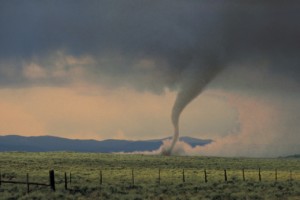Are We Getting Better at Predicting Tornadoes?
In a recent podcast, we took a close look at why it’s so difficult to predict earthquakes, even though several million occur each year around the world. After a series of violent tornadoes tore through much of the American south over the last few days, killing at least 43 people, it’s a good time to ask: how good are we at predicting tornadoes? Even as parts of the country recover from one of the deadliest tornado outbursts in years, a handful of innovations are taking shape that should begin improving our ability to predict when a twister might strike.
First, some context. Tornadoes are almost entirely an American dilemma. Thanks to the unique blend of arctic and tropical air currents that flow across the U.S., no other country gets more tornadoes than the 1,000 or so that touch down in the U.S. each year. As evidence of their sporadic, unpredictable nature, annual death tolls from tornadoes are highly erratic, going along at double-digits with periodic spikes of triple-digit annual causalities every few years. For example, in 1974, 366 people died from tornadoes. In 1975, the number shrunk to 60. (See here for a complete list of annual death tolls from tornadoes.)
While advancements in warning systems over the last 50 years, mostly from the National Weather Service, have significantly cut tornado deaths, there remain periodic spikes. Like in 2008, when 125 people were killed by tornadoes. Of course when evaluating the number of fatalities, we have to consider the broader demographic shifts south and west that have led to increased populations in tornado hotbeds like Texas, Oklahoma, and Missouri over the last decade.
But it appears we may be entering a period of improvement. In Norman, Okla., smack in the middle of Tornado Alley, meteorologists at the National Weather Service have begun testing the largest upgrade to the nation’s weather radars since Doppler was installed in the early 1990s. The new technology, called ‘dual polarization,’ is specifically designed to improve tornado spotting. Over the next two years, the upgrade will be installed at all 169 National Weather Service Doppler radars. By improving forecasting, it should also speed our ability to get the word out through more targeted and timely weather alerts on TV and online.
Since many tornadoes are spawned by violent thunderstorms, AccuWeather.com senior meteorologist Henry Margusity has developed a classification system for thunderstorms using what he calls a “TS Scale,” similar to the Enhanced Fujita scale used for classifying tornadoes and the Saffir-Simpson scale used for hurricanes. Margusity has been beta-testing the system on his blog and apparently hopes to have the system available to download on mobile devices sometime soon.
The current master of tornado prediction is Dr. Greg Forbes of the Weather Channel, whose recently developed Tornado Condition Index system, or TOR:CON, is widely seen as the most accurate at the moment. TOR:CON calculates a percentage risk of a tornado developing within 50 miles of a specific location due to thunderstorm activity. Forbes has developed somewhat of a cult following this spring. The wall of his Facebook page is filled with comments from his 10,000 fans, asking him questions and thanking him for his predictions.
Amendment: Post has been amended to remove mention of meteorologist Kevin Martin.


Comments